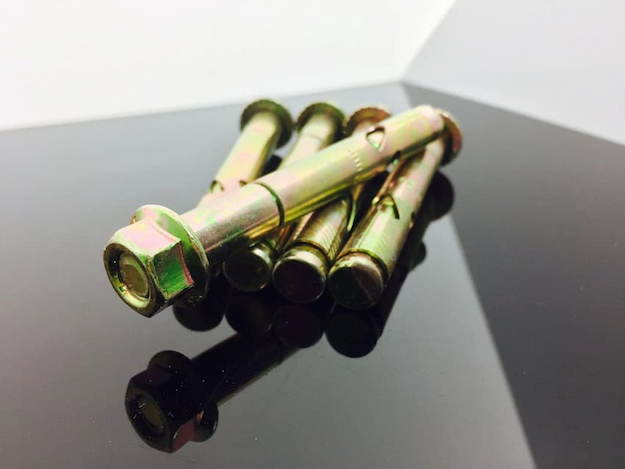Whenever you need to attach metal and wooden items to concrete, brick or stone, you’ll be foraging through toolboxes and drawers for sleeve anchors. These are some of the most versatile fasteners, with high holding power owing to their unique construction and uses that span everyday household jobs to large-scale commercial and industrial applications.
Each anchor can comfortably carry up to 100 kilos, or enough to securely hold heavier additions, such as decking joists or door and window frames, and lighter items, including handrails, support brackets, junction boxes, and more. The fasteners have become a household name in tradie circles, where they’re known as Dynabolts.
The Basics of Dynabolt Sleeve Anchors
Sleeve bolts are a type of pre-assembled mechanical expansion anchor. They consist of a metal sleeve around a threaded bolt or stud (hence the name) and an expansion cone at the end. The sleeve expands when the head (either a nut or screw) is tightened, pressing the sleeve against the cone and securing the fastened item to the base material through a pre-drilled hole. This can be solid or cracked concrete, concrete block, grout-filed block, solid or hollow brick, or stone.
The vast selection of materials and finishes, high strength and head styles make buying a Dynabolt anchor ideal for numerous light- or heavy-duty anchoring applications, both indoors and outdoors.
Major Types
The versatility of sleeve anchors and Dynabolts is down to the large selection of head types:
- Hex nut head – this includes an expansion sleeve over a threaded stud and a nut and washer as a head. Anchoring is simple – just apply the appropriate torque to the nut with a wrench or spanner to tighten the anchor.
- Hex bolt head – for permanent fixtures and high holding strength choose a Dynabolt sleeve anchor with a hex bolt head. This often includes a washer under the head to evenly distribute the load and prevent play.
- Countersunk – clean finishes, with anchors sitting flush with the surface, are achieved using a countersunk or flat sleeve anchor. Besides aesthetics, the fastener increases safety by not protruding outwards and catching on any items. Use a screwdriver to tighten the anchor and attach the object to the substrate.
- Round head – when attaching wooden items to masonry, round head sleeve anchors work best. Like countersunk types, they too are fastened with a screwdriver. Both types differ from hex head and hex nut anchors in that you can remove them.
- Eye and hook head – ropes, cables and wires can be suspended in overhead applications, for instance from ceilings, using eye anchors. These have higher holding strength due to the anchor expanding against the base material, so are suited to larger and heavier items. Hook head Dynabolts commonly have similar uses.
- Tie wire head – when installing wires, cable ties, conduits or ducting in overhead applications, use tie wire head Dynabolts.
Material Options
Materials determine overall strength, and treatment processes dictate where the anchors can be used. For the highest holding and tensile strength, choose 304 or 316-grade austenitic stainless steel. These can adequately hold heavier items without exhibiting metal fatigue and also work well in harsh outdoor settings, being corrosion and heat-resistant. The only downside is that you’ll be paying a little more for all the added benefits.
In light and medium-duty projects, choose hot-dip galvanised carbon steel. The coating resists rust outdoors, and the high carbon content offers decent strength. ideal uses include electrical boxes, conduit runs, and shelving.
Lastly, go with zinc-plated mild or carbon steel for light-duty application indoors. These adequately deal with minor exposure to liquids, have good strength, and are the cheapest to buy.
Sizing Them Right
Diameters in sleeve anchors are that of the pre-drilled hole, so match the drill bits. Metric widths include 6, 8, 10, 12, 16 and 20mm, or 1/4, 1/3, 3/8, 1/2, 5/8 and 3/4″ in imperial units. Lengths usually (but not always) correlate with the width of the anchor to ensure correct holding strength. This can vary from 25 to 150mm, or 1″ to 6″.
Headed anchors are measured from the head tip to the end of the bolt, whereas nut-driven bolt anchors are measured as the length of the bolt only. Understandably, longer and wider Dynabolts have higher strength and clamping force but also require more torque to expand the sleeve into the masonry.
How Dynabolts Compare to Other Anchors
Dynabolts are branded sleeve anchors produced by local company Ramset, a subsidiary of Illinois Tool Works, or ITW. The versatility, easy installation, and higher clamping force make Dynabolt sleeve anchors the preferred fasteners in many applications and base materials. They are stronger than concrete screw anchors, can carry much higher loads, and are equally quick to install.
Wedge anchors have high load capacities and are better suited for heavy-duty applications, but are limited to solid concrete. The complexity, time-consuming installation and cost of chemical anchors make these appropriate for specialist uses. For general anchoring applications, where costs and installation times need to be balanced with durability and strength, Dynabolts offer unmatched flexibility.
Advantages of Using Dynabolts
Quick installation, minimal insertion effort, the ability to work in all masonry, and the high resistance to shear and pullout forces make a Dynabolt anchor the popular choice for hundreds of applications. The anchors come in many head types and sizes, are optioned in materials that work in multiple settings and weather conditions, are pre-assembled and ready for use, and are sourced in the same diameter as the holes they’re used in.
The design grips the substrate from all sides for higher load capacities, reduces the likelihood of damage (especially in hollow masonry) and is only second to chemical anchors for edge and close-distance anchoring. Another advantage is that the sleeve anchors can be installed through the object to be fastened. Their reasonable price compared to other anchors is another selling point.
Using Sleeve Anchors
Installing a sleeve anchor is relatively simple and requires a few basic steps. Drill a hole in the same diameter and roughly the same length as the sleeve anchor. Clean the hole with a brush or air tool. Insert the anchor in the hole and lightly hammer it until the head and washer contact the expansion cone. Follow up by tightening the head or nut to expand the sleeve and secure the bolt against the substrate.




